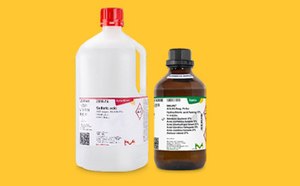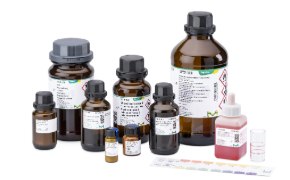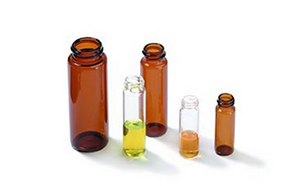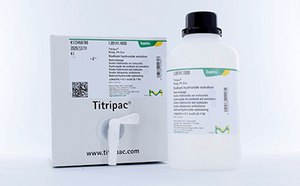Wet Chemical Analysis
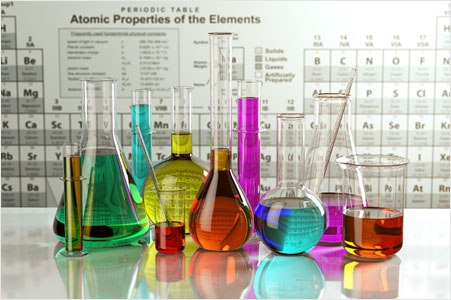
Wet chemical analysis involves identifying and quantifying the desired elements present in a liquid sample using several methods. It can be divided into two main types, the qualitative analysis identifies the elements and the quantitative analysis determines the quantity. With chemical reagents, the analyte can be used to convert a dye proportionally, which can be read-out visually or photometrically.
The wet chemical analysis comprises a multitude of techniques, including titration, distillation, spectrophotometry (UV/Vis/IR), colorimetry, filtration, drying, weighing, pH tests, and direct read with electrodes. These methods of analysis may be more labor-intensive compared to other methods as automation can’t be applied to some of these techniques.
Featured Categories
Uncover a wide acid range: Supelco® for analysis, Sigma-Aldrich® for labs, SAFC® for biopharma. Tailor solutions for varied needs.
Our large portfolio of high-quality indicators will enable you to accurately determine the endpoint for a wide range of titration types.
Ensure precise analysis: Inert, certified vials prevent extractables, leachables. Reduce risk with Supelco® autosampler, general-purpose vials for HPLC, GC/MS, LC/MS.
Our broad range of volumetric solutions make titration results trustful. Sophisticated packaging like the Titripac® and 3S cap and innovative solutions to improve the titration process. Seamless data transfer via RFID tag is available with our SmartChemicals and 3S reagents.
pH Measurements
pH quantifies the amount of free hydrogen and hydroxyl ions present in the water and therefore, the pH value (0-14, 7 being neutral) indicates the acidity and alkalinity of a solution. pH measurement is the most significant test performed in laboratories as many of the physical, chemical, and biological processes are dependent on pH. The pH measurement using pH meter gives the most accurate results. A pH meter measures the voltage difference between two electrodes when dipped in a solution. Standard buffer solutions are used for calibration of the pH meter to produce reliable and reproducible results.
BOD Determination
Biochemical oxygen demand (BOD) measures the amount of dissolved oxygen consumed by microorganisms in the aerobic decomposition of organic matter from water. BOD determination estimates the amount of biodegradable organic matter present in wastewater, effluent, and polluted waters. The two widely used methods for BOD measurement are the dilution method and the manometric method.
- Dilution method: This is a standard method wherein the sample (dilution water) is prepared by adding inorganic nutrients, buffer salts, and sufficient amounts of bacteria to purified water. Several dilution levels of the sample are then prepared. The BOD bottles are filled to the top, capped, sealed, and incubated in the dark at 20 °C for 5 days. The dissolved oxygen levels are measured before and after the 5-day incubation period. The difference in these two values, corrected for the dilution and the blank, is the BOD5 value.
- Manometric method: In this method, a manometer is fitted into a bottle that contains an undiluted sample. It continuously monitors the air pressure drop inside the bottle, which reflects the amount of oxygen uptake by the sample. This method is easier than the dilution method since no dilution is required, and continuous measurements are achievable.
COD Determination
Chemical oxygen demand (COD) is the measurement of oxygen required to chemically oxidize organic substances in water. Therefore, COD evaluates water and wastewater quality.
The COD test is carried out in the presence of a strong oxidant under acidic conditions. A known excess of the oxidant is added to the sample and once the oxidation is complete, the amount of oxidant remaining in the solution is estimated by titration using an indicator solution. The COD test takes up to 2-3 hours to complete as compared to BOD (5 days) and measures all organic contaminants, including the non-biodegradable organics.
COD can be analyzed using a cuvette pre-filled with reagents containing chromium (VI) that converts to chromium (III) by the organic contaminants of the sample during the thermal pre-treatment. The amount of chromium (VI) consumed is proportional to the amount of COD and can be detected directly through photometry.
NP Analyzers
Soil nutrients such as nitrogen (N) and phosphorus (P) are essential in plant growth. An increase in N deposits harms the soil ecosystem as it increases soil acidity, creates a nutrient imbalance, alters the composition of soil microbes, and contributes to increased emission of greenhouse gas. Hence, it is necessary to routinely test N in food and environmental laboratories.
There are many methods for the determination of N. These methods require an initial oxidation step that converts nitrogen-containing organic compounds to inorganic nitrogen entities. The oxidation step can be carried out by either one of these methods: (1) Kjeldahl digestion, (2) ultraviolet (UV) oxidation, (3) persulfate oxidation, and (4) high-temperature oxidation (combustion).
Measuring P has become a crucial step in environmental analysis. High levels of P and N in water bodies can compromise the quality of water, as they trigger the rapid growth of toxic algae. Analysis of P is usually performed by the ascorbic acid-molybdate method, e.g. by a ready-to-use test kit which is quantitatively analyzed by a photometer. N and P analyzers can be stand-alone instruments or a combination of both the analyzers.
TOC Analysis
Total organic carbon (TOC) determines the amount of carbon present in an organic compound. TOC is a highly sensitive, non-specific measurement of all organic matter present in a sample. It is, therefore used to regulate the organic chemical discharge to the environment in a manufacturing plant. Detection of TOC is also an important aspect in the field of potable water purification due to the disinfection of byproducts. There are different approaches to determine TOC:
- Off-line measurements performed on water samples collected into containers and transported to an instrument.
- On-line measurements, the instrument is connected directly to the purified water stream.
- Oxidation of organic molecules.
- Instruments that determine TOC, designed to selectively detect CO2.
This method is often considered as a complementary method to COD and can also be performed with specific cell test kits.
Dissolution / Digestion
Sample preparation is in important step in the analytical process. Samples are often not suitable for direct analysis and therefore need a sample preparation step. It’s the aim to convert the analyte into a homogeneously dissolved form. As the quantity of reagents used for sample preparation is high compared to the sample itself, reagents have to be of appropriate purity to avoid contamination of the sample or false positive results. Sample preparation includes techniques like dissolution, digestion, melting, extraction and many more. In inorganic analysis often digestion is used to convert hardly soluble samples into a liquid and thus easy-to-analyze form. Acids, caustic alkalis, bases and salts are used as digestion agents and have to be available in good quality to avoid contamination of the sample.
Gravimetric Analysis
Gravimetric analysis is used in analytical chemistry for the quantitative determination of an analyte based on its mass. Different types of this method of analysis contain precipitation, volatilization and electro-analytical method. Several inorganic reagents are necessary for gravimetric analysis to receive the desired reaction with the analyte.
Visit our document search for data sheets, certificates and technical documentation.
Related Articles
- Glass bottles are ideal for storing acids because they are inert and offer a long shelf life.
- The titer determination or standardization of a titration solution is essential for accurate and reliable titration results.
- The percent oxidation of a phospholipid can be determined by using Beer’s Law to calculate the peroxidized phospholipid’s concentration from its absorbance at 234 nm.
- A transmittance to absorbance table enables fast conversion from transmittance values to absorbance in the lab or in the field.
- Essential steps to identifying your optimal water system. From quality to greener technologies & space saving options.
- See All (20)
Related Protocols
- Analytical Method COD measurement in wastewater - Photometric determination of chromate consumption subsequent to digestion in 20 min.
- Photometric determination with Chromazurole S subsequent to acid mineralisation; DIN decomposition
- Density bottles determine liquid density, calibrated 'to contain' for accuracy, though not volumetric instruments like volumetric flasks.
- Preparation of a standard solution for total chlorine.
- Photometric determination with Chromazurole S subsequent to acid mineralisation
- See All (96)
Find More Articles and Protocols
How Can We Help
In case of any questions, please submit a customer support request
or talk to our customer service team:
Email custserv@sial.com
or call +1 (800) 244-1173
Additional Support
- Chromatogram Search
Use the Chromatogram Search to identify unknown compounds in your sample.
- Calculators & Apps
Web Toolbox - science research tools and resources for analytical chemistry, life science, chemical synthesis and materials science.
- Customer Support Request
Customer support including help with orders, products, accounts, and website technical issues.
- FAQ
Explore our Frequently Asked Questions for answers to commonly asked questions about our products and services.
To continue reading please sign in or create an account.
Don't Have An Account?